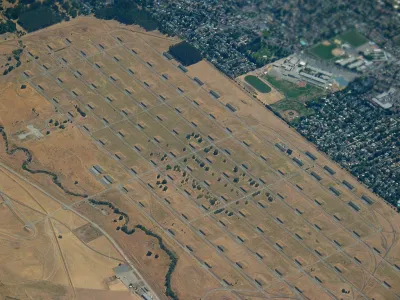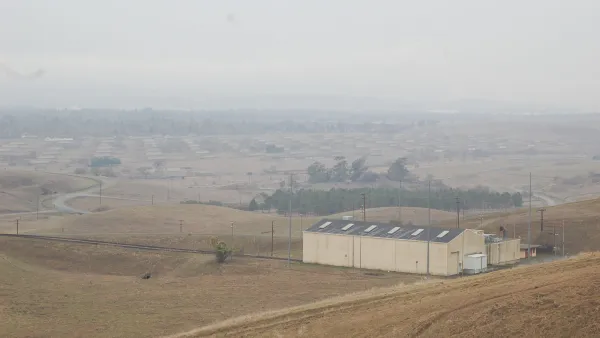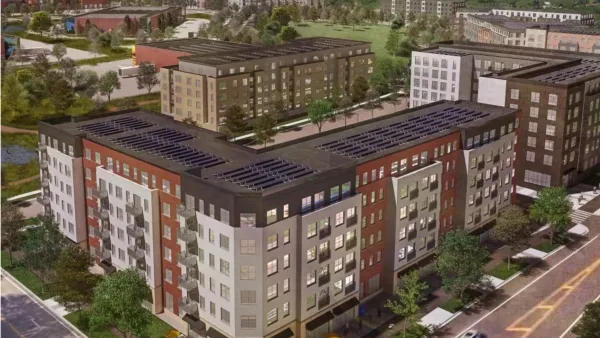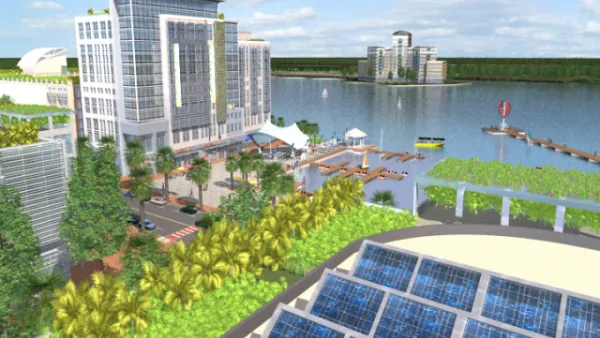The city of Concord, home to 130,000 but often neglected in the public consciousness of the San Francisco Bay Area, could set new standards for master planning practices.

John King provides a detailed update on one of the largest mega-development projects in Northern California right now—the $6 billion plan to convert a former naval weapons station to a master planned community including 13,000 homes, BART access, and a new approach to integrating a mix of uses into a new community.
"The potential canvas" for the project, writes King, "is the Concord Naval Weapons Station, a vast terrain dotted with trees and dozens of partially concealed ammunition bunkers."
"The emerging vision would place 13,000 housing units in structures ranging from multistory apartments above shaded colonnades to single-family homes on snug village greens. A transit corridor flanked by bicycle lanes would extend the length of the 3.4-mile-long site. Office buildings would cluster near the BART station at one end — parting to make room for a paseo-like footpath leading up to a ridgeline park."
While the project has been in works for the entire decade, a full plan and a draft environmental report are expected this winter, according to King, with a City Council vote on the project not likely for another year after that.
More than just providing details news coverage of the project, King also lends an assessment, as the San Francisco Chronicle's urban design critic, of the project's value to the city and the larger Bay Area. According to King, "in a region hobbled by the challenge of finding ways to add sizable amounts of housing in a manner that feels humane, the scenario in Concord offers heartening promise on a truly large scale."
In addition to the project's ability to deliver a large amount of housing in a supply constrained market, King also approves of how the planning and design details of the project are taking shape:
Plans at this stage often promise more than real life delivers. There’s no shortage of infill “placemaking” efforts in recent years that are hollow shells of their initial hype.
Nevertheless, it’s exciting to see a major firm focused on large-scale suburban futures — how to add density in a way that would take cues from its more settled surroundings while adding new layers to the scene.
FULL STORY: Concord weapons station has fraught history, but development concept has promise

National Parks Layoffs Will Cause Communities to Lose Billions
Thousands of essential park workers were laid off this week, just before the busy spring break season.

Retro-silient?: America’s First “Eco-burb,” The Woodlands Turns 50
A master-planned community north of Houston offers lessons on green infrastructure and resilient design, but falls short of its founder’s lofty affordability and walkability goals.

Delivering for America Plan Will Downgrade Mail Service in at Least 49.5 Percent of Zip Codes
Republican and Democrat lawmakers criticize the plan for its disproportionate negative impact on rural communities.

Test News Post 1
This is a summary

Test News Headline 46
Test for the image on the front page.

Balancing Bombs and Butterflies: How the National Guard Protects a Rare Species
The National Guard at Fort Indiantown Gap uses GIS technology and land management strategies to balance military training with conservation efforts, ensuring the survival of the rare eastern regal fritillary butterfly.
Urban Design for Planners 1: Software Tools
This six-course series explores essential urban design concepts using open source software and equips planners with the tools they need to participate fully in the urban design process.
Planning for Universal Design
Learn the tools for implementing Universal Design in planning regulations.
EMC Planning Group, Inc.
Planetizen
Planetizen
Mpact (formerly Rail~Volution)
Great Falls Development Authority, Inc.
HUDs Office of Policy Development and Research
NYU Wagner Graduate School of Public Service





























